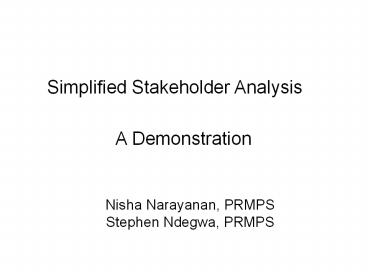Nisha%20Narayanan,%20PRMPS%20Stephen%20Ndegwa,%20PRMPS - PowerPoint PPT Presentation
Title:
Nisha%20Narayanan,%20PRMPS%20Stephen%20Ndegwa,%20PRMPS
Description:
Accessible charts and grids as guides for potential options/targets for ... reform preferences to the right or diagonally upwards by increasing information ... – PowerPoint PPT presentation
Number of Views:41
Avg rating:3.0/5.0
Title: Nisha%20Narayanan,%20PRMPS%20Stephen%20Ndegwa,%20PRMPS
1
Nisha Narayanan, PRMPSStephen Ndegwa, PRMPS
Simplified Stakeholder Analysis
A Demonstration
2
Goals
- Demonstration, preliminary use
- Simple, user-friendly and portable model
- Transparent calculations and assumptions
- Scenario building over prediction
- Accessible charts and grids as guides for
potential options/targets for policy dialogue
3
Data Collection
- As with other models, extensive and reliant on
field interviews - Depending on government or policy area openness,
data can be collected by two methods - Interviews with specialists or experts and/or
- Interviews with actual stakeholders
4
Data Attributes
Annex 1 New Effective Power equation
5
Sample Data
6
Policy Continuum A
7
New Policy Continuum B
() Effective Power
8
Effective Power/Position MatrixIdentifies
stakeholder position and their relative power --
how hard reform will be With simple rule --
movement within quadrant/subset -- allows setting
goals to influence
9
Scenarios Governing Assumptions
- Stakeholders can only move within their policy
preference sector, or minimally into next one - Strategy may then be to
- Move stakeholders with low policy reform
preferences to the right or diagonally upwards by
increasing information - Empower stakeholders with higher policy reform
preferences to move up and to the right by
increasing effective power
10
Influence-Salience MatrixIdentifies the
stakeholders by their level of salience and
influence (color-coded on policy reform
preference)Information on stakeholder attributes
allows setting intervention strategy and
coalition building
11
Specific Examples in response to
influence-salience profile of opponents
- Promoters - counter or compromise
- Defenders - suppress potential action
- Latents Increase salience
- Apathetics - Ignore
12
Specific Examples in response to
influence-salience profile of proponents
- Promoters - Build coalitions with low preference
stakeholders-common interests - Defenders - Provide resources to promote position
- Latents - Provide information and incentives to
increase saliency and preference for reform - Apathetics Ignore
13
New Policy Continuum B
() Effective Power
14
Improvements/Simplifications
- Adds detailed stakeholder reservation price to
policy continuum - Clarifies effective power equation
- Focuses on creating scenarios in lieu of
predictions to promote policy - Uses maps to identify and assess stakeholder
positions and potential movement for dialogue and
goal-setting
15
Conclusion
- Simpler model
- Portable, cost effective
- Excel-based
- WB team executed (data/scenarios/dialogue)
- Transparent assumptions
- Informed by Task team country/issue knowledge
- Theoretically valid, methodologically reliable
- Organic scenarios over precise/debatable
predictions
16
Annex 1 Effective Power Equation
- (.70)I (.30)S Effective Power
- Effective Power is the weighted sum of 70
Influence and 30 Salience - Influence is weighted more than Salience because
those with higher influence have a higher ability
to block reform - Eg. A stakeholder with 80 (I) and 20 (S) has more
power to veto a policy than a stakeholder with 20
(I) and 80 (S)
17
More Information
- On Sentias Model, Other Models used elsewhere,
Bank Pilots, and Simplified Model, please
contact - Stephen Ndegwa/Nisha Narayanan
- Ed Campos/Shilpa Pradhan (PRMPS)
- Barbara Nunberg/Amanda Green (EASPR)
- Jennie Litvack/Nabil Chaherli (MNSED)































